How To Make Garlicky Dill Pickles
For some reason people think making pickles is difficult. But, making pickles isn’t hard, especially once you get the hang of it. My twin sister thinks I’m some sort genius at this kind of culinary art and should write a book about said practice. Once you understand the nuances in flavor that help create the brine, it really isn’t rocket science. Hell, if I can do it, pretty much anyone with half a brain can. There is some trial and error, so if you’re just starting out be prepared to throw some food away. Even I still stumble. I recently cracked a jar of pickled rhubarb from last year, since rhubarb is now in season, and was planning on replacing last year’s canned bounty with this year’s offering. The first bite was immediately spit into the kitchen sink. Who the F made this garbage!?! Oh right, yours truly. Not that the flavor was off or had spoiled (thankfully) but the acid in the brine had turned the rhubarb to complete mush over time. Lesson learned. So you’re going to win some and you’re going to loose some but over time you’ll be knocking it out of the park like you’re a freaking starter for the best baseball team in the league (aka The RED SOX, duh!).
But before we get into the actual recipe and it’s steps, let’s give a quick synopsis of what it means to be a “pickle.” Most Americans seem to think a pickle is just a fancy, spiced-up cucumber, looking down it’s nose at it’s boring cousin. Sure that’s true, but what is being pickled doesn’t have to be a cucumber. As I stated earlier, I’ve pickled rhubarb. I also have a jar of pickled cherries I’m waiting to open and recently posted a pickled garlic scape recipe. I haven’t done it yet, but you can even pickle eggs. The closest I’ve ever come to that is a pickled egg juice-back after a whiskey shot, and don’t even get me started on what a sh*t show of a night out in NYC that was! So, as Portlandia famously stated and is oft quoted around our house, “You can pickle that!”
That said, there are different forms of pickling and certain kinds work better for whatever is being preserved. The easiest method, which I’ll be showcasing, is “quick pickles” aka “refrigerator pickles.” Moving on from there, “freezer pickles” are usually fruit based since the sugar content helps seal in flavor. Indian cuisine also has many pickles but we Americans living in a very sheltered food world, call all them “chutneys.” Asian food also has many types of pickles. I mean, Korea practically runs on Kim Chi.
Which leads me to the most complex way to pickle something, “fermentation.” I won’t get into the complicated process here and will save it for another time but yes, you probably have at some point eaten a fermented cucumber labeled as a “pickle.” Ever had a “full sour” or “half sour” pickle? Yeah those tasty little things sat out at room temperature long enough for cultures to form and give tartness to the cucumber. Hot Doug’s (RIP) in Chicago had a killer version of the full sour and in my experiments, that meant the batch sat out for about two weeks. I dare you to leave something on the counter for that long, consume it and be whisked off to tastebud Nirvana. (No, PLEASE don’t do that!) More likely than not you’ll be spewing your guts out. But hey “A” for effort! I digress. Let’s get this pickle party pumping…
GARLICKY DILL PICKLES
1# Pickling Cucumbers
5 Sprigs Fresh Dill
3 Garlic Cloves
4 Chiles De Arbol
1/2 t Whole Peppercorns
1/2 t Whole Coriander Seeds
1 1/2 t Salt
1 t Sugar
1 C Water
1 1/2 C Distilled Vinegar
Pickling cucumbers come in all shapes and sizes. Some farmers will actually sell their ugly looking regular cucumbers as pickling ones. They work but have a higher water content and less sturdy flesh so they’re not ideal for this process. What you’re looking for are the stubby, bumpy, is-that-safe-to-put-in-my-mouth kind of cucumber. You may have to trim your cucumber down into spears (or into rounds if you prefer) but I selected little whole ones. I love shoving whole pickles in my mouth, take that as you will. So give your cukes a rinse before cutting it if doing so, as well as the dill. Let them dry and place them in a quart jar, alternating between pickles and dill. Why do you think we do that? To help spread the flavor of dill around.
Next up you’re going to take your garlic cloves and gently crush them. You can smash them if you had a bad day at the office but I’d recommend taking the flat edge of a chefs knife, blade away from you (come on, safety first!) on top of a clove and apply pressure until you feel the clove crack. Feel free to increase the amount of garlic if you really dig on that sort of thing, and the same goes for the chile de arbol if you like pickles with a little more heat. Take all of the ingredients and put them in a pot, give it a quick stir, and crank it up to high on the stove. Heat the mixture until the salt and sugar has dissolved. If you’re unsure if they have, just bring it to a boil.
Now this is important <read- don’t screw it up>
Remove the mixture from heat and allow it to COOL to room temperature. Despite all of their tough looking exterior, cucumbers are delicate. If you pour hot liquid over them, they just go soft. Also, before pouring the brine over the stuff in the jar, give it one last stir to mix up all the aromatics. Pour the brine to cover the cucumbers and turn the jar over a couple of times to mix up everything. Don’t shake it. Remember what I said about delicate! Place it in the fridge and let it sit for at least 48 hours. If you have ants in your pants, 24 hours will work, but you are missing out on some serious flavor country. The longer they sit the better they get and could even last over a year. But if those delicious little cukes are still there that long, you should probably just stick to eating fast food.
Last but not least, there are a million and one pickling books out there (another reason I won’t be writing one anytime soon, sorry sis) but I really love “The Joy of Pickling” by Linda Ziedrich. It has very user friendly recipes which taste great. The book features easy pickling recipes as well as more complex ways of preserving food. But wait there’s more! (I swear I’m not getting paid for this.) The Joy of Pickling has a global perspective and features recipes from around the world, as well as short pieces on each area’s use of pickles and their ingredients.
As always feel free to contact me for questions or recipes, I do have larger industrial-sized pickling recipes if you want to go crazy!
Cheers,
Chef Sean
Two Ways To Use Garlic Scapes
- At June 22, 2017
- By Sean Smith
- In garlic, pickled things
 0
0
Garlic Scapes? What the hell are they? Spell check doesn’t even recognize the word!
Well, I’d like to simplify it, and my farmer friends, please give me a pass on some of the botanical elements. A “scape” is the part of a garlic bulb that pushes through the dirt and then grows a stalk. These stalks will eventually flower so that said underground bulb can produce enough energy for the plant to reproduce via it’s flowers. Sounds lovely, right?
Well unfortunately for us foodies, that’s a load of shite. With garlic, as well as host of other veggies, as soon as the plant starts to “bolt” (the process of flowering above ground), the plant shifts energy from the bulb to the top of the plant in hopes it will sow it’s seeds. That transfer reduces the flavor in the bulb, but, isn’t that the thing we care most about! So in early summer garlic farmers walk down their fields and trim off the scapes, trapping all the plants energy in the bulb. What does that mean? Concentrating “Flavor Country” bitches!
So where does that leave the unwanted bi-product of the growing process? Garlic scapes have a flavor that of course is “garlicky,” albeit in a very toned-down way. Because they see some sun, they can also come across as what a “scallion” is to a whole onion, greener and a little more feisty. Damn you youth! (shaking fist rigorously) The next time you see these curly, wiggly lookin’ green stalks at your farmer’s market or grocer, buy some. The following awesome recipes are a great way to showcase the flavors that this once cast-off has to offer.
GRILLED GARLIC SCAPE PESTO
3/4# Garlic Scapes, grilled & roughly chopped
3/4 C Walnuts, toasted
1 C Parmasean, grated
1 C Basil
1 C Olive Oil
Juice of small lemon
Salt
DIRECTIONS:
Combine scapes, walnuts & a 1/4 C of the oil in food processor, puree to a paste, scrapping down sides as needed. Add in basil and pulse until roughly chopped. With machine running slowly add in remaining EVOO. Once fully combined add in cheese and pulse to incorporate. Season with lemon juice & salt to taste.
PICKLED GARLIC SCAPES
1/2# Garlic Scapes, cleaned & cut into 2” pieces
7 Dried Thai Chilies (or Dried Chili De Arbol)
4 Bay Leaves
2 t Fennel Seed
1 t Whole Peppercorn
1 t Whole Coriander
1/2 t Whole Mustard Seed
1/2 C Sugar
3 T Salt
2 C Water
2 C Distilled White Wine Vinegar
Combine all ingredients except scapes in a pot and bring to boil, reduce to simmer until sugar & salt is dissolved. Meanwhile portion cut scapes between a quart and a pint jar. While pickling liquid is hot, pour over scapes, taking care to make sure the aromatics are split between both jars. Seal while hot.
Any questions or comments please feel to reach out to me. Unless that includes hate mail, then please contact my wife.
Cheers,
Chef Sean
The Farmhouse Tap & Grill, Burlington, VT
I always enjoy a good meal on my trips to Burlington, and this trip was no different. Sean and I were staying at Homeplace Bed & Breakfast, and had a great discussion with Mariot the owner over breakfast. Mariot was explaining to us that up in Vermont local food is incredibly local. Restaurants source cheeses, meats, eggs, and vegetables often from within a few miles’ radius. Local doesn’t just mean local to the state or region. A cheese plate in Burlington, for example, is likely very different from a cheese plate in Brattleboro or Montpelier, Mariot explained. Before finishing breakfast I had already decided I needed some local cheese that afternoon.
We met one of Sean’s sisters for lunch in downtown Burlington and decided to eat al fresco on a gorgeously sunny September afternoon at The Farmhouse Tap & Grill. As soon as I flipped their menu over, I was reminded of the morning’s conversation with Mariot:
Their menu highlights nineteen different local farms, the towns where you’ll find the farms, and what they provide the restaurant. It then mentions twelve local cheese makers. We just don’t see too much of this in Colorado…
As I was on a northeast cider tasting tour, I tried some cider on tap. Sean was all about local beer. I didn’t write down which ones we tried, so these will go unnamed.
The first thing I look for on menus at restaurants like this is pickles. Of course they had house made pickles!
Roasted beets and goat cheese, both locally sourced, were also on the top of my list for lunch.
The cheese plate was also fun. Sean picked a few from the menu to custom build a plate with some apple butter and jam.
Everyone was SO patient while I snapped photos, and then food was quickly devoured. Next came our actual lunch. Sean had the Farmhouse Veggie Burger with Cabot cheddar, house made kimchi, and pickled jalapeños with fries.
His sister Angela had their Misty Knoll Free Range Turkey Burger with Vermont farmstead Tilsit cheese, cranberry mostarda, arugula, charred onions, and fries.
And I went for the Farmhouse Veggie Sandwich with house made hummus, Landaff Creamery “Landaff” cheese, Jericho Settler’s Farm carrots, dill pickles, local sprouts, grilled zucchini, herbed yogurt, on Red Hen Bread. I, as usual, went with a side salad to complement my veggie sandwich rather than fries. I’m just no fun!
We had a great lunch on their beautiful patio, and I’d definitely go back.
160 Bank Street, Burlington, VT 05401
802.859.0888
Portland Cocktail Week, Night 1
I’m in Portland, OR for Portland Cocktail Week. All I have is my iPad, so posting is possible, but not ideal, and I can’t link to things, so I will go back and edit later. I will be sure to write a recap when this work-vacation is over. But, my first night was a blast! Of course it was… I was with Sammy Dunn, my friend going on 10 years now. A man who knows about the Portland food scene and likes to have fun. What else could I ask for in life?
Sam picked me up at the airport and we went straight to Biwa for a fantastic dinner. Kimchi, pickled mackerel, a fried sardine, burdock and carrot salad, fermented soy beans that have a raw quail egg to make them gooey, fried rice balls, some other pickled stuff, and a couple ginger gimlets. Now, here’s what my receipt says we ate:
Yoyogi, Saba Nanbanzuke, Yakionigiri, Kimchi, Natto, Kinpira, Sardine, and Ginger Gimlet.
Yeah. I have a lot to learn about this fusion cuisine and if we had a place like Biwa in Boulder, I could study more.
From Biwa we walked to Cascade Brewing and tasted some sour ales- Barrel #1 Platinum Blond, Apricot, Sang Royal, and Kriek. Oh, for the love of sour style beers.
Then we finished the night the way old friends should- with a bottle of what appeared to be an 04 vintage of Pinot Noir from The Adea Wine Company of Willamette Valley. I say “appears” because the label is missing and there’s some hand written words on the bottle that indicate 04 Pinot Noir. Some secret stash? Quite possibly.
Off to explore food, coffee, and cocktails today. Definitely can’t complain.
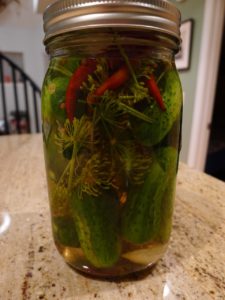




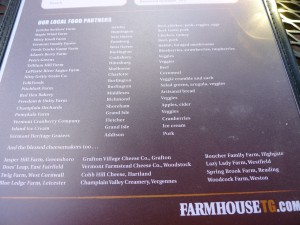
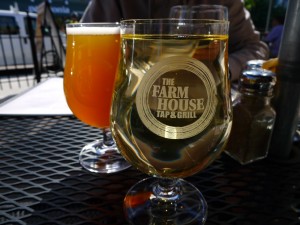
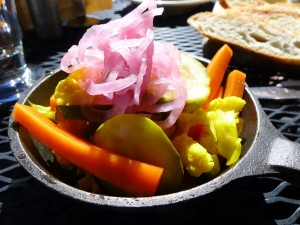
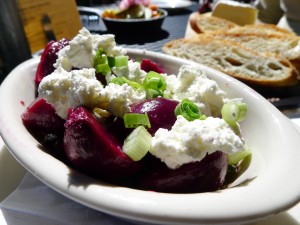


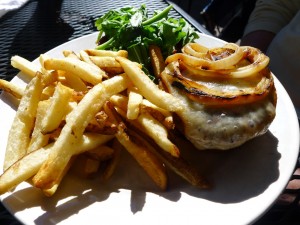
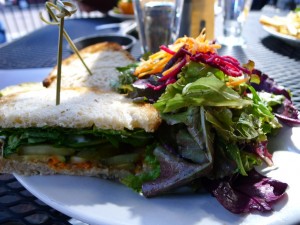
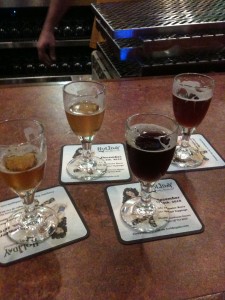
Let’s get Social